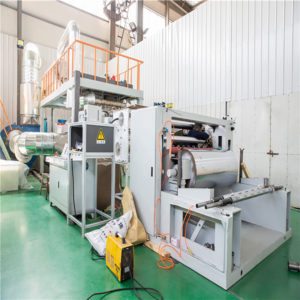The typical range of fiber diameters and basis weights that can be achieved with PP Melt blown Machines can vary based on machine specifications and settings.
However, here is a general overview of the range:
Fiber Diameters:
- Ultrafine Fibers: PP Melt blown Machines are capable of producing ultrafine fibers with diameters in the range of 0.5 to 5 micrometers (µm). These ultrafine fibers are a defining feature of melt-blown nonwoven fabrics and are prized for their filtration and barrier properties.
- Fine Fibers: Melt-blown fabrics often contain fine fibers with diameters ranging from 2 µm to 10 µm. These fibers contribute to the fabric’s filtration efficiency and can be used in various filtration applications.
- Medium Fibers: In some cases, PP Melt blown Machines can produce melt-blown nonwoven fabrics with medium-sized fibers in the range of 10 µm to 20 µm. These fabrics may have a broader range of applications, including medical and hygiene products.
Basis Weights:
- Lightweight: Melt-blown nonwoven fabrics with lightweight basis weights can start at around 10 grams per square meter (gsm) or even lower. These lightweight fabrics are used in applications such as face masks, air filters, and disposable gowns.
- Medium Weight: Melt-blown fabrics with medium basis weights typically range from 20 gsm to 60 gsm. They are commonly used in a variety of applications, including surgical drapes, wound dressings, and industrial filtration.
- Heavyweight: Some melt-blown nonwoven fabrics can have basis weights exceeding 60 gsm. These heavyweight fabrics are used in applications that require greater strength and durability, such as industrial wipes and protective clothing.
It’s important to note that the specific fiber diameter and basis weight achieved with a PP Melt blown Machine can be adjusted by controlling factors such as polymer extrusion rate, air pressure, and the design of the die or spinneret. The choice of these parameters depends on the desired characteristics and performance of the melt-blown nonwoven fabric for a particular application. Manufacturers may customize their machines and processes to meet the requirements of their target products and markets.
What environmental considerations are associated with the use of PP Melt blown Machines?
The use of PP Melt blown Machines, like any industrial process, has several environmental considerations.
Here are some of the key environmental aspects associated with these machines:
- Energy Consumption: PP Melt blown Machines require energy to operate, primarily for polymer extrusion, air handling, and other processes. Optimizing energy efficiency through the use of energy-efficient machinery and processes can help reduce the environmental impact.
- Resource Consumption: The production of polypropylene (PP) resin, which is a key raw material for melt-blown nonwoven fabrics, requires the use of natural resources. PP Melt blown Machine Sustainable sourcing of raw materials and the reduction of waste in the production process are important considerations.
- Emissions: Emissions from the production and operation of PP Melt blown Machines can have environmental consequences. Controlling and minimizing emissions of greenhouse gases and pollutants, such as volatile organic compounds (VOCs), is crucial to reduce the carbon footprint and environmental impact.
- Waste Generation: The production process can generate waste materials, including defective nonwoven fabric and trimmings. Implementing waste reduction strategies, recycling programs, and responsible waste disposal methods can mitigate the environmental impact.
- Chemical Usage: Some melt-blown processes involve the use of chemicals, such as additives and colorants. Proper handling and disposal of these chemicals are essential to prevent environmental contamination.
- End-of-Life Considerations: When melt-blown nonwoven products reach the end of their life cycle, their disposal methods can impact the environment. Some nonwoven products may be incinerated, landfilled, or recycled. Encouraging recycling and responsible disposal practices can reduce waste.
- Microplastic Pollution: Melt-blown nonwoven fabrics can shed microplastic particles over time, especially during use and washing. These microplastics can enter the environment and marine ecosystems, posing potential ecological and environmental challenges. Developing solutions to minimize microplastic release is an ongoing concern.
- Sustainability Initiatives: Many manufacturers are actively working on sustainability initiatives, such as adopting closed-loop recycling systems, reducing water usage, and minimizing waste generation. These efforts aim to make the production of melt-blown nonwoven fabrics more sustainable.
- Eco-Friendly Alternatives: Research and development efforts are focused on developing more sustainable and eco-friendly alternatives to traditional polypropylene materials. This includes exploring bio-based polymers and biodegradable materials for melt-blown fabric production.
- Product Lifecycle Assessment: Conducting a comprehensive assessment of the entire product lifecycle, from raw material extraction to disposal, helps identify areas where environmental improvements can be made.
Environmental considerations associated with PP Melt blown Machines are crucial as the industry strives to minimize its environmental impact and align with sustainable practices. Efforts to reduce energy consumption, minimize waste, and explore eco-friendly alternatives are ongoing in the pursuit of more environmentally responsible production processes.
